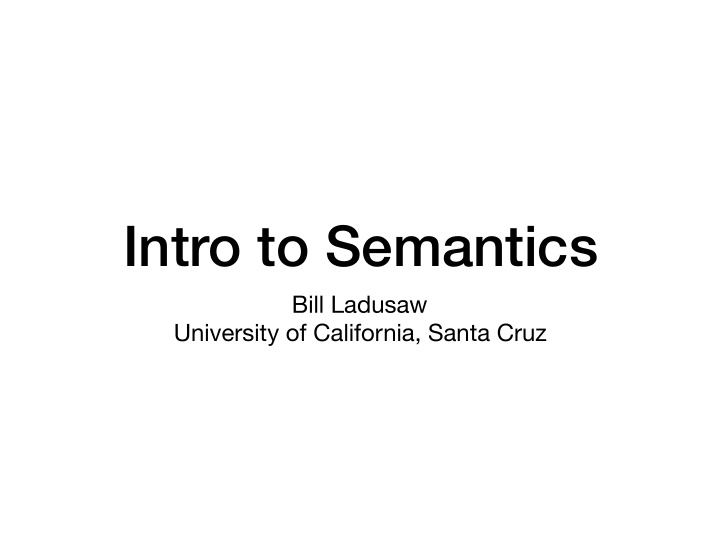



Intro to Semantics Bill Ladusaw University of California, Santa Cruz
Course Overview • ladusaw@ucsc.edu • Canvas resources (Files, Announcements, Assignments?) • Attendance and weekly “responses” due by Tuesday class • O ffi ce Hours: T-F by arrangement • Library Reserves: Portner and Kearns • LSA Statements
Syllabus • F 7/7: Meaning & Understanding; Context & Content • T 7/11: Basics of Formal semantics • F 7/14: Predicates and their arguments • T 7/18: Reference, generality, descriptions, & opacity • F 7/21: Quantification • T 7/25: Tense, aspect, modality, and attitudes • F 7/28: Given, new, focus, and discourse coherence • T 8/1: Punchlines, themes, and horizons
Ready to Begin?
Four Guideposts on Meaning , Inference, and Communication
I. The Front Door • Unexpected situations trigger hypotheses about what’s going on (interpretations) • Hypotheses are sensitive to background and contextual circumstances. • The door doesn’t intend for you to understand it.
The Dumb Show • Unexpected action from another cognitive agent • Hypothesis is about the goal of the agent • Decision to accept or object subsequent to interpretation
Buying Limes in Egypt • Market as situational frame • Shared background increases e ff ectiveness and e ffi ciency • Knowledge of language not needed; Knowledge of ??? crucial.
Coffeeshop Sign • Do not serve dead customers. • To anyone.
Coffeeshop Sign Do not serve dead customers. To anybody. • Metaphorically dead • Creepy subject • Intricacy of knowledge of language • Processing in real time
Utterance Understanding ≠ Sentence Meaning Natural meaning Speaker’s meaning Linguistic meaning
Slicing the Onion of Interpretation • Cognitive agents interpreting their environment • Interpreting the behavior/actions of other agents (hypotheses about communicative intent) • Recognizing background information and context • Assessing shared background and context (“Common ground”) • Knowledge of the language: conventional linguistic meaning
The (Gricean) Pragmatic Envelope • After I handed her the book, she gave it back to me . • Is Jim in his o ffi ce? • Yes/No • The light is on. • I hear someone talking in there. • I like you a lot.
Unpacking Context • Participants • Location (temporal, spatial) • Deixis and indexicality here, there, then, now, this, that, before, ago • Reference into the described situation (aboutness)
Where is “Semantics” ?
Recommend
More recommend